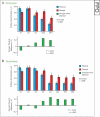The emergence of perceived position in the visual system
- PMID: 20044886
- PMCID: PMC2907423
- DOI: 10.1162/jocn.2010.21417
The emergence of perceived position in the visual system
Abstract
Representing object position is one of the most critical functions of the visual system, but this task is not as simple as reading off an object's retinal coordinates. A rich body of literature has demonstrated that the position in which we perceive an object depends not only on retinotopy but also on factors such as attention, eye movements, object and scene motion, and frames of reference, to name a few. Despite the distinction between perceived and retinal position, strikingly little is known about how or where perceived position is represented in the brain. In the present study, we dissociated retinal and perceived object position to test the relative precision of retina-centered versus percept-centered position coding in a number of independently defined visual areas. In an fMRI experiment, subjects performed a five-alternative forced-choice position discrimination task; our analysis focused on the trials in which subjects misperceived the positions of the stimuli. Using a multivariate pattern analysis to track the coupling of the BOLD response with incremental changes in physical and perceived position, we found that activity in higher level areas--middle temporal complex, fusiform face area, parahippocampal place area, lateral occipital cortex, and posterior fusiform gyrus--more precisely reflected the reported positions than the physical positions of the stimuli. In early visual areas, this preferential coding of perceived position was absent or reversed. Our results demonstrate a new kind of spatial topography present in higher level visual areas in which an object's position is encoded according to its perceived rather than retinal location. We term such percept-centered encoding “perceptotopy".
Figures






Similar articles
-
Temporal limitations in object processing across the human ventral visual pathway.J Neurophysiol. 2007 Jul;98(1):382-93. doi: 10.1152/jn.00568.2006. Epub 2007 May 9. J Neurophysiol. 2007. PMID: 17493920
-
Class information predicts activation by object fragments in human object areas.J Cogn Neurosci. 2008 Jul;20(7):1189-206. doi: 10.1162/jocn.2008.20082. J Cogn Neurosci. 2008. PMID: 18284342
-
Feedback of visual object information to foveal retinotopic cortex.Nat Neurosci. 2008 Dec;11(12):1439-45. doi: 10.1038/nn.2218. Epub 2008 Nov 2. Nat Neurosci. 2008. PMID: 18978780 Free PMC article.
-
Human cortical areas underlying the perception of optic flow: brain imaging studies.Int Rev Neurobiol. 2000;44:269-92. doi: 10.1016/s0074-7742(08)60746-1. Int Rev Neurobiol. 2000. PMID: 10605650 Review.
-
Neural representations for object perception: structure, category, and adaptive coding.Annu Rev Neurosci. 2011;34:45-67. doi: 10.1146/annurev-neuro-060909-153218. Annu Rev Neurosci. 2011. PMID: 21438683 Review.
Cited by
-
Resetting capacity limitations revealed by long-lasting elimination of attentional blink through training.Proc Natl Acad Sci U S A. 2012 Jul 24;109(30):12242-7. doi: 10.1073/pnas.1203972109. Epub 2012 Jul 9. Proc Natl Acad Sci U S A. 2012. PMID: 22778408 Free PMC article.
-
Non-retinotopic feature processing in the absence of retinotopic spatial layout and the construction of perceptual space from motion.Vision Res. 2012 Oct 15;71:10-7. doi: 10.1016/j.visres.2012.08.009. Epub 2012 Aug 21. Vision Res. 2012. PMID: 22929811 Free PMC article.
-
Idiosyncratic perception: a link between acuity, perceived position and apparent size.Proc Biol Sci. 2020 Jul 8;287(1930):20200825. doi: 10.1098/rspb.2020.0825. Epub 2020 Jul 8. Proc Biol Sci. 2020. PMID: 32635869 Free PMC article.
-
Crowding is tuned for perceived (not physical) location.J Vis. 2011 Aug 8;11(9):10.1167/11.9.2 2. doi: 10.1167/11.9.2. J Vis. 2011. PMID: 21824980 Free PMC article.
-
Decoding patterns of human brain activity.Annu Rev Psychol. 2012;63:483-509. doi: 10.1146/annurev-psych-120710-100412. Epub 2011 Sep 19. Annu Rev Psychol. 2012. PMID: 21943172 Free PMC article. Review.
References
-
- Altmann CF, Deubelius A, Kourtzi Z. Shape saliency modulates contextual processing in the human lateral occipital complex. Journal of Cognitive Neuroscience. 2004;16:794–804. - PubMed
-
- Andersen RA, Snyder LH, Bradley DC, Xing J. Multimodal representation of space in the posterior parietal cortex and its use in planning movements. Annual Review of Neuroscience. 1997;20:303–330. - PubMed
-
- Avidan G, Hasson U, Hendler T, Zohary E, Malach R. Analysis of the neuronal selectivity underlying low fMRI signals. Current Biology. 2002;12:964–972. - PubMed
-
- Benjamini Y, Hochberg Y. Controlling the false discovery rate—A practical and powerful approach to multiple testing. Journal of the Royal Statistical Society, Series B, Methodological. 1995;57:289–300.
MeSH terms
Substances
Grants and funding
LinkOut - more resources
Full Text Sources

